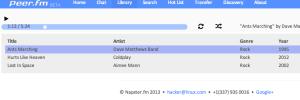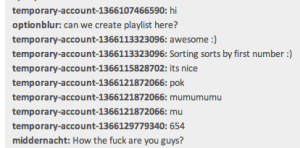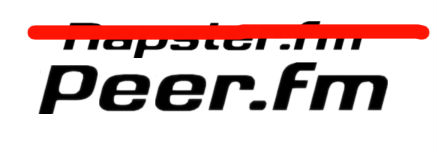Last week, we told you about an open source alternative to music services such as Rdio and Spotify, called Napster.fm. The name alone got our attention, and after using it, there were a few features that were reminiscent of its predecessor, which made it even cooler.
Today, the service is changing its name to Peer.fm to steer clear of legal issues, since Best Buy acquired the service and brand and shipped it over to Rhapsody in 2011, or whatever is left of it. Other than that, its been business as usual for its creator, Ryan Lester.
Lester tell us that he’s had nearly 100k visitors to the site, with over 59,000 users actually trying out its features. Right now, nearly 1,500 users are registered and getting all of the benefits that come with that, including its social functionality that allows you to share tracks and playlists with friends.
Most of the traffic is coming from outside of the United States, 64 percent, with areas of the world that don’t have access to Spotify bringing the heaviest users.
We chatted with Lester about his project, which is noteworthy for its open-source nature. He told us that he’d love to make the service available to mobile users, but is focusing on translating the service for as many languages as possible:
TC: What has been the most used feature on the service thus far?
 Ryan Lester: Well, not surprisingly, just playing music. It’s looking like the more social-oriented features are starting to pick up some steam, but just the core music-playing functionality easily tops the rest in usage.
Ryan Lester: Well, not surprisingly, just playing music. It’s looking like the more social-oriented features are starting to pick up some steam, but just the core music-playing functionality easily tops the rest in usage.
TC: There are a lot of music services out there. Why did people gravitate to yours?
Ryan Lester: I think there are a few important reasons for this:
1. It’s definitely something cool and new that people into music will want to try at least once, and being open source earns a certain level of cachet and goodwill.
2. Despite still being in Beta, the quality of the software is definitely in the same league as that of its major competitors (e.g. Spotify, Google Music); on top of that, it adds a few unique features of its own like syncing music between users in real-time.
3. Napster had a cool social element which hadn’t really been precisely replicated by newer services until Peer.fm showed up. On a related note, I’m sure quite a few people use it out of nostalgia for the old Napster days.
4. In most of the world, there aren’t a ton of other options (just take a look at Spotify’s geographic availability sometime).
5. Being completely free definitely doesn’t hurt :).
 TC: Are others asking to join and help you build out the open source project?
TC: Are others asking to join and help you build out the open source project?
Ryan Lester: Not a whole lot, but I have gotten a few code contributions for some minor display issues that would probably have taken me a couple of weeks to get to myself, and some offers to contribute to artwork and/or private testing in the future when necessary (which is really awesome to have willing volunteers for).
Other than that, I’ve mainly had people email/text me about how psyched they are to have something like this released as open source.
TC: What features are you working on next?
Ryan Lester: Top of my list in the short-term: language localization for non-English speakers; this is way too important to ignore with 64 percent of my traffic originating from outside the U.S.
Outside of that, the major features at the top of my queue are multiple playlist support (as opposed to having only one massive library) and the ability to import music collections from other sources (especially iTunes).
More long-term, I’ll be looking to extend Peer.fm support for mobile devices, but I really couldn’t give any kind of time estimate on that at the moment.
———
By being open source, Lester can keep building out the features that the community wants, as well as allow others to jump into the code themselves. In the same way that WordPress got traction from developers who had a pure love for publishing, Peer.fm could attract a similar following and involvement for music.
Don’t be fooled though, the service isn’t paying for the music its streaming, and neither are the users, which will definitely make it a target for shutdown. The open source nature of it means that it can be re-opened in minutes, though. As we reported before, the way that the music is pulled in is due to “minor inefficiencies in YouTube’s piracy-detection system,” which haven’t seem to have been closed up yet. If that were to happen, then the project could be in jeopardy.
However, I honestly believe that at some point, there will be an open source alternative to iTunes and Spotify, something that indie musicians can get behind and have a part in building. Once it attracts a few larger artists, then it could be a force to be reckoned with.
Could Peer.fm be it? It’s the only reason that I heard the name “Rhapsody” in the past three years, so that counts for something, right?
